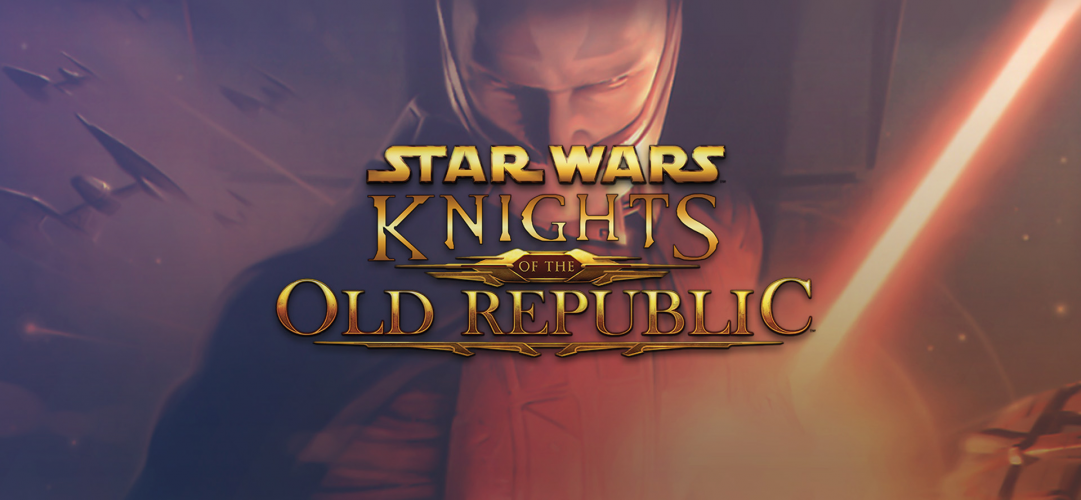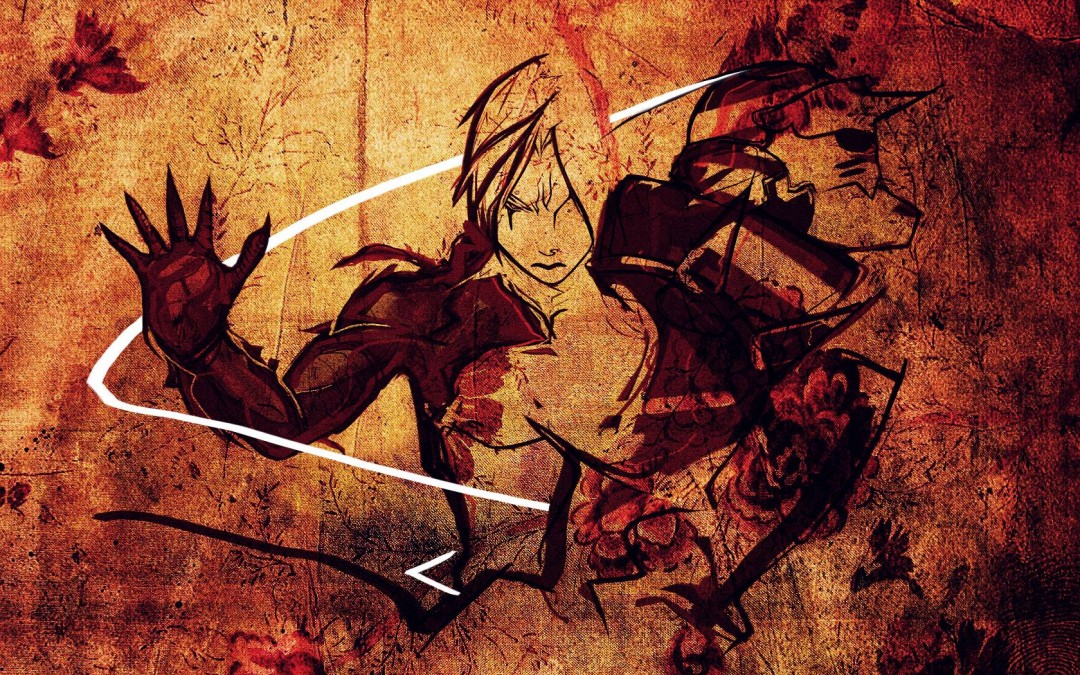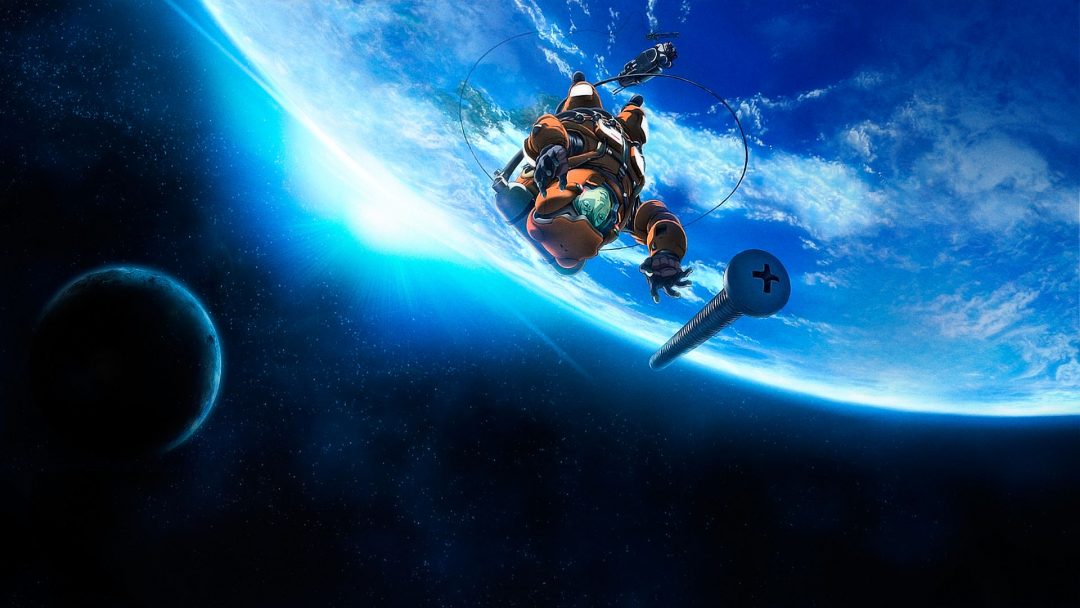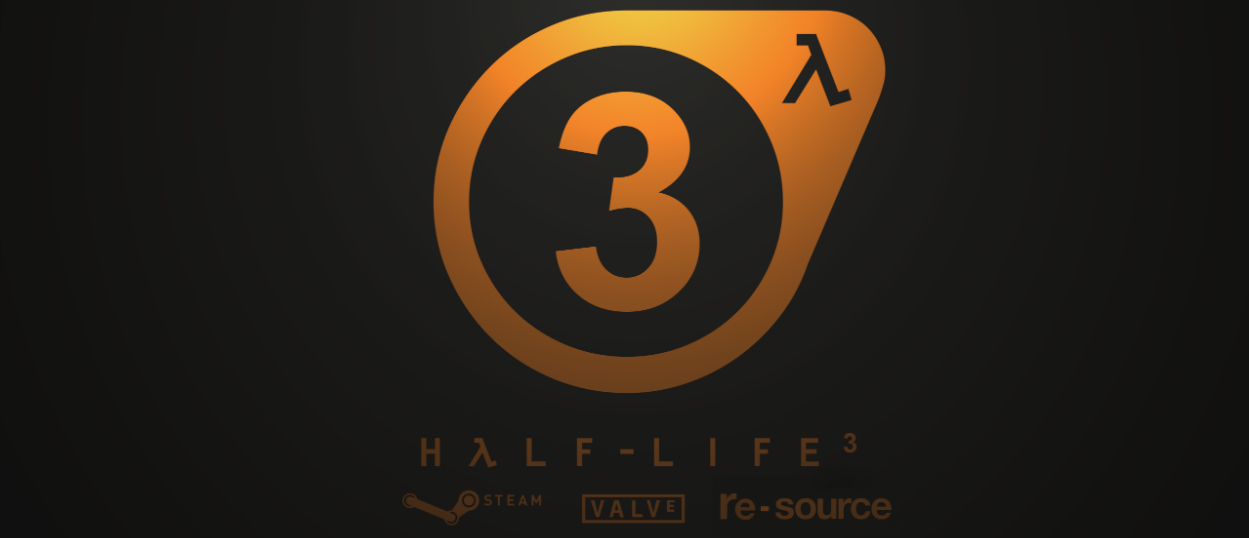Star Wars has been on my mind a lot lately — on everyone’s minds, it seems. As a lifelong fan, I’ve spent a good part of my life immersing myself in the Star Wars universe across a number of spin-off games, books, comics, and animated TV series. Although those immersive opportunities are many and varied, finding the truly quality experiences are hard to separate from all the Bantha poodoo.
So it was that for our month of nostalgia I decided to dust off the discs of an old favorite and replay BioWare’s 2003 RPG, Star Wars: Knights of the Old Republic. Since first playing the game in 2005, I’ve become very acquainted with what I’ve come to expect from a “BioWare RPG.” They are behind two of my favorite recent game series, Dragon Age and Mass Effect. I was curious to see how KotOR would hold up in the ten years I’d played it and if it was the template for the BioWare’s later successes.
Presentation
KotOR features all the visual and audio trappings of any proper Star Wars offering. From the opening crawl down to the beeps and whirrs of astromech droids, KotOR seems right at home as a part of the Star Wars universe. Of particular note are the voices for the alien races. Rodians, Ithorians, Twi’leks, Duros — their voices all sound lifted straight from the films. Some of the initial immersion was lost once I noticed the same dialogue would not only be the same for each alien but would loop in the same conversation. Still, that is an attention to detail that I find highly commendable. I did a little digging and found that LucasArts took on all the sound, which credits the high standard voice acting and sound design. That left BioWare in charge of visuals.
As expected, playing KotOR in 2016 leaves a bit to be desired in the graphics department. It lacks the retro charm many older games can get away with, but it’s aged as well as a thirteen-year-old game can. Things look a little blurry at 800 X 600, but I’m not going to hate on it for that. Dynamic camera work is present here, with plenty of close-ups and framed shots that make the game feel like an authentic piece of Star Wars history. Characters’ mouths move when they speak, and I’ve got to give BioWare credit for syncing up their lips to boot.
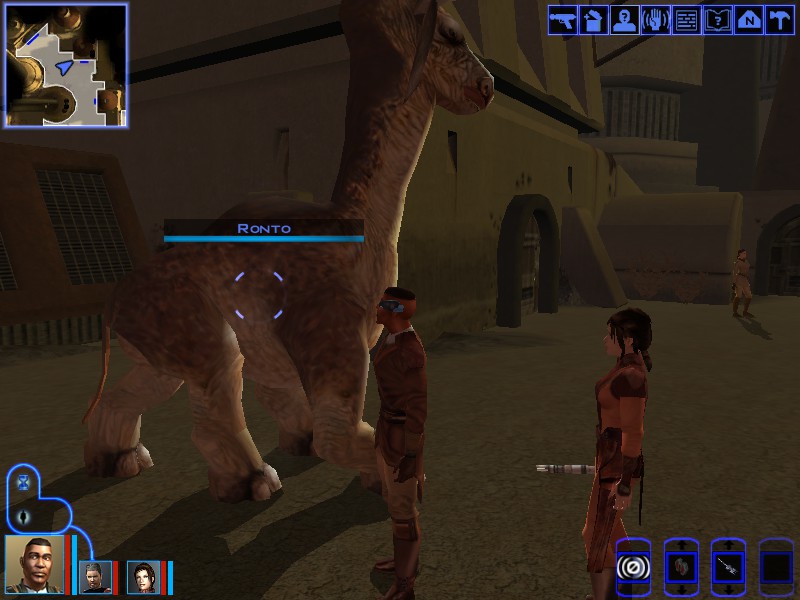
I remembered the environments being pretty drab when I’d played KotOR before, and my memory certainly didn’t fail me. Aside from some decent lighting effects (the warm Dantooine sunset makes for a comfortable-looking Jedi refuge), most outdoor environments lack personality. Tatooine’s Dune Sea is one of the worst offenders with wide, flat sand as far as the draw distance can render. While the distant heat waves are an admittedly nice touch, there are few dunes to speak of. The indoor environments are a bit different, with plenty of compartments to loot and tight hallways for close-quarters skirmishes, bringing to mind the Death Star corridor firefights from A New Hope.
Force powers are probably the only notable visual element that deserves special mention. Force lightning looks as sinister as it did when erupting from Palpatine’s fingers in Return of the Jedi, while thrown lightsabers hurtle through the air in satisfying arcs.
Gameplay
The greatest challenge in revisiting old games is actually playing them. It’s always a toss up see whether the minute-to-minute gameplay will hold up over the years, or if it will show its age. KotOR is an RPG, which means it could run pretty long. Potentially, I was looking at 30+ hours of antiquated combat, and if those systems didn’t grab me from the start, then it was going to be a tough slog. I had a bad feeling about this.
KotOR uses BioWare’s Odyssey Engine, which unfortunately for me was based on the same engine in their previous release, the Forgotten Realms RPG Neverwinter Nights. I say “unfortunately” because that is a game I have tried time and again to dive into, but I quickly tired of the plodding combat. Maybe it’s because I played these games after having spent so much of my time in more responsive, action-y RPGs like The Witcher, Diablo, or even World of Warcraft. But this engine doesn’t do KotOR any favors. What should be visceral third-person lightsaber combat seems distanced by using the unreliable dice rolls of the D&D systems. True, there’s something reverent about those using systems, and they are obviously made for gaming, but there’s no DM to turn your bad dice rolls into delightful narrative beats; failing to land hits is a frustrating, tiresome experience.
I chose the Easy difficulty so I could plow through the game and get the experience as fast as possible, but combat sometimes demanded a lot of my patience (and a lot of reloaded saves) anyway. I did, however, discover an instant fast-travel function I had failed to notice when I’d first played the game. This delightful mechanic saved me from tons of backtracking, letting me get back to the action (arduous as it was at times) as quickly as possible. BioWare has since moved away from dice-rolling in their later games in favor of more dynamic forms of gameplay like aiming spells or first-person shooting. It’s a fundamental change I’m glad to see they’ve moved on from.
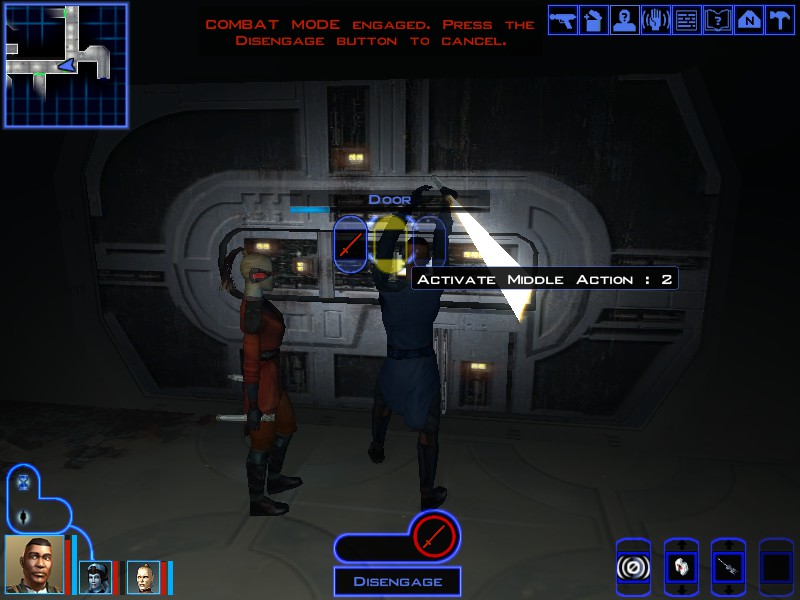
On the other hand, many of the non-combat elements of KotOR have held up really well. Pazaak, the blackjack-esque mini-game I ignored the first time around, is actually a lot of fun. It’s no Gwent, but the game did offer some decent diversion while questing. Same goes for swoop racing, a high-speed, podracing-inspired mini-game. Both serve to pad your coin purse while making the world seem rich.
The other way to earn money, and more importantly, XP is through quests. Quest goals are diverse and thrust a lot of choice-driven conflicts on the player that can result in earning Dark side or Light side points — the precursor of the Mass Effect’s Paragon/Renegade alignment system. Even simple fetch quests have an opportunity to increase these points, depending on whom you deliver the package to. In an early part of the game, finding a medicinal serum can cure an entire population, or earn you a boatload of credits when put in the hands of unsavory characters. I did find that quests more often than not laid the outcomes before me, forcing me to make tough decisions rather than letting me see the repercussions for having chosen one option over another. These dilemmas were usually presented by two foil characters, each representing the light or dark option.
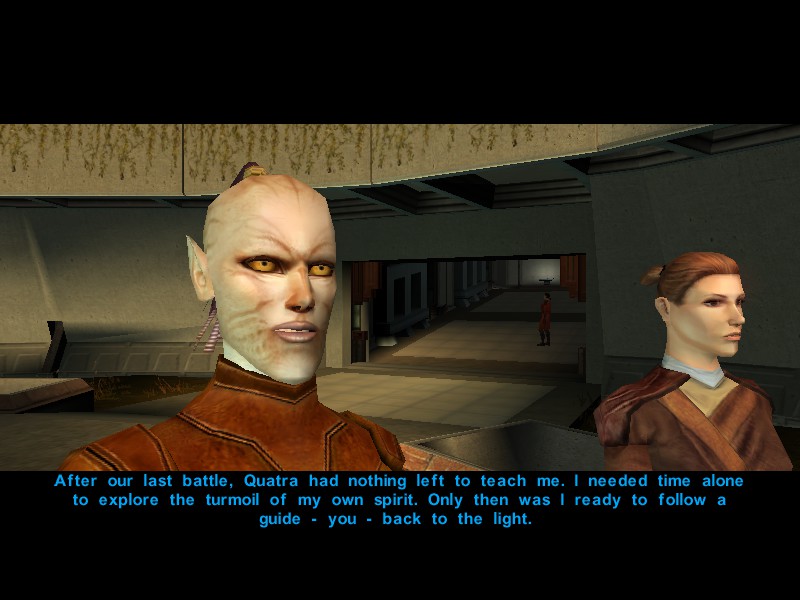
Star Wars has never boasted a subtle stance on the struggle of good versus evil, choosing to paint those conflicts in more universal, if rigid, terms. But leave it to BioWare to insert a little of that oh-so-rich gray area. I did several quests where even the actions of the supposed “good guys” were not painted in a great light, which made my character seem dynamic by comparison.
The Legacy
In general, RPGs are weighed by two things: their stories and their characters. KotOR has remained memorable to those who have played it for having both. Its story meets all the key requirements of what makes Star Wars a fun space opera adventure. There are exciting worlds to explore, high stakes action, and a sense of mystery weaved throughout from beginning to end. I must commend BioWare for maintaining the feel of the Star Wars universe in every part of KotOR’s grand, worlds-spanning plot.
Character interactions have become a hallmark of BioWare RPGs, and KotOR’s are no exception. Banter between party members occurs while questing out in the real world, which makes the game feel like you’re carving out your own Star Wars story. You can also initiate conversations with them aboard your ship. This has carried over into both Dragon Age and Mass Effect, where you can travel to separate parts of your home base to learn more about your companions. In Dragon Age you meet with everyone in camp; in Mass Effect you hoof it around the Normandy to talk to your compadres. But for BioWare’s third-person RPGs, it all started with the Ebon Hawk, your own personal starship.
The party itself includes a colorful cast, typical of any BioWare game, who seem right at home in the Star Wars universe. There’s a scoundrel and wookie duo, a moody Republic commando — even a snarky assassin droid. Uncovering their backstories and building relationships with them always feels rewarding; it was clear from the get-go that BioWare were operating in another level even in 2003. I felt the ever-present sense of “companion anxiety,” deliberating on who to bring on every outing — the testament of BioWare’s dedication to crafting compelling characters. And it’s not just party members; interactions with NPCs are interesting as well. I remember being thrilled at being able to choose my own conversations when I first played the game. Although dialogue choices aren’t very diverse, (you usually have the choice of a light, neutral, and dark side option), but it works. BioWare hasn’t changed up this formula much since, but getting to choose my own reactions and take my character on my chosen path fulfilled a very specific Star Wars fantasy that could only be fully realized in video game form.

To that end, BioWare’s Star Wars: Knights of the Old Republic is still very much the definitive Star Wars RPG everyone remembers. It is, however, the prototype to much more advanced, tighter BioWare games, both in terms of story and gameplay. That it was of such a high caliber over ten years ago is a marvel that deserves to be seen for yourself, even if for only a handful of hours. The concepts of strong characters and large worlds to explore have all carried over into what we can all expect as part of BioWare’s DNA.
When I first played the game ten years ago, I didn’t know what a gem I had on my hands; all I knew is that it was Star Wars and it was fun. And those two things are still absolutely true about KotOR.
Retrograde: Still Fully Operational

